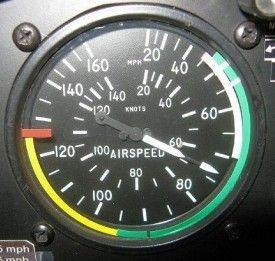Scott Hotaling contacted the Cafe about his interest in contributing articles related to glider training and geared toward students pilots. Scott said, “These articles are very hard to find and I’ve talked to students who are actively looking for this type of training aid.” We agreed with him and are please to provide his first installment.
Scott is currently a student pilot taking lessons in upstate New York. He says, “It’s been an incredible and exciting experience thus far!” — the Cafe Editors
When you take your first driving lesson, the speedometer is simple to read. There’s just numbers. Simple. No colors to worry about. The tachometer is a little more difficult, but not much. You just need to figure out why the end of it is colored in red. Red is bad. Okay, so maybe it’s not more difficult.
 The airspeed indicator in a glider is much more colorful. There’s green, red, yellow and white. The first time I saw it I thought it was a Christmas decoration! I found out later those colors all meant something, something very important. It’s time to get colorful, with limited colors!
The airspeed indicator in a glider is much more colorful. There’s green, red, yellow and white. The first time I saw it I thought it was a Christmas decoration! I found out later those colors all meant something, something very important. It’s time to get colorful, with limited colors!
The white arc on the airspeed indicator is the flap operating range of the glider. These are the speeds at which you may use the flaps safely. The lower limit of the white arc is the stall speed in the landing configuration. This can also be referred to as the minimum steady flight speed with flaps and landing gear fully extended. Flaps and landing gear fully extended is, of course, the landing configuration. This speed is abbreviated, Vso.
As we increase airspeed we approach the green arc. This arc is the normal operating range of the glider. Speeds in the green arc refer to landing gear and flaps retracted. When flying at these speeds, flaps and landing gear may be used, but only because the white arc is also found at these airspeeds. The lower limit of the green arc is the stall speed in this configuration. It is abbreviated Vs1.
The upper limit of the white arc is the flaps extended maximum speed. Structural damage may occur if flaps are extended beyond this speed. Pay close attention to this limit. Gliders soar much farther when they are in one piece. This speed is abbreviated, Vfe.
The upper limit of the green arc is the maximum cruising speed of the glider. It’s called Vno. Just like Vfe, going beyond this limit may cause structural damage to your aircraft. Technically, you can go faster than this, but only in non-turbulent air. But even if it’s a calm day, yellow always means one thing, caution.
If you’re flying in the yellow arc, make sure you pay careful attention to that red line. That’s where all bets are off and structural damage can result even if you’re flying in smooth air. It’s the glider’s Vne speed. I’m sure you can guess what the n and e stands for. It’s the velocity you should never exceed. Yes, that means never, for any reason.
A speed that you won’t find on the airspeed indicator is the glider’s maneuvering speed. This is the maximum speed at which the glider’s limit load factor will not be exceeded. This speed, referred to as VA, is based on the glider’s maximum gross weight. In strong turbulence, you should not fly beyond this airspeed due to the risk of severe structural damage. A very important point to maneuvering speed is that it decreases as the weight of the glider decreases. These speeds are called operating maneuvering speeds and are abbreviated Vo. Vo is the speed that the glider will stall before the limit load factor is reached.
There are a few more you won’t find on the airspeed indicator, but you’ll want to get to know them. They’ll keep you in the air the longest, allow you to travel the farthest, and they’ll change slightly, based on the weather conditions. This is one of the reasons that soaring takes a lot more skill than some of us beginners realize.
The minimum sink speed is the speed that the glider loses the least amount of altitude in a given period of time. This will result in the maximum duration of flight time, in calm weather.
The best glide speed is the speed that the glider loses the least amount of altitude for a given distance. It’s also called the best L/D speed, or lift/drag speed. This speed results in the greatest distance of travel in calm weather.
Now you can choose your speed wisely. But remember, the goal is to have fun, regardless of how fast you’re flying, I mean soaring!
By Scott Hotaling
References:
- Glider Performance Airspeeds
- Rod Machado’s Private Pilot eHandbook 2nd Edition. The Aviation Speakers Bureau 2009
- Glider Flying Handbook. U.S. Department of Transportation, Federal Aviation Administration 2003







2 comments for “Limited Colors”